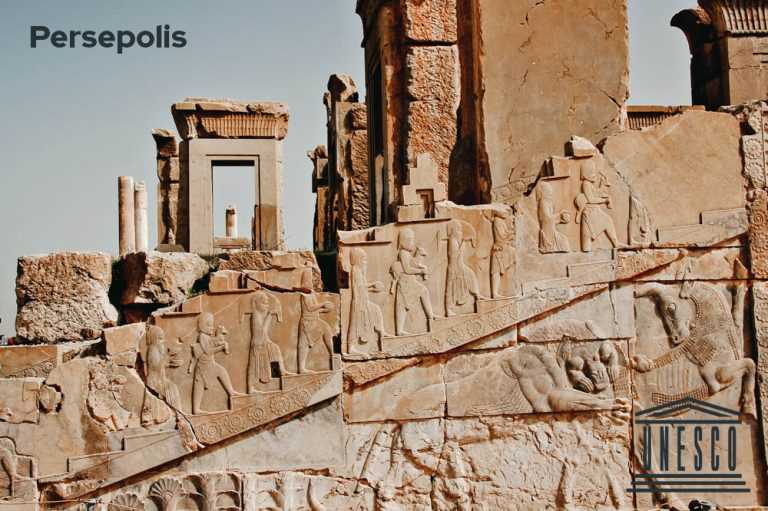We can take some time for an unforgettable Shiraz travel. Shiraz itself is near the ancient city of Persepolis or Takht-e Jamshid. Under the shining light of the Sun, fields of wheat dance gently and give us a graceful bow to say everybody is always welcome here, in the city of peace.
The first sign of Persepolis Shiraz is a holly mountain range that was important for the ancient people. If you listen carefully, you can hear the bell sound of the camels from a passing caravan. The travelers can transfer the reputation of the Achaemenid empire’s new capital city.
As a holy site stood here on an ancient caravan road. It is said that Cyrus the Great chose this place to establish a palace now called Takht-e Jamshid. When the fame of the grand palaces reached Greece, they called the new city Persepolis, which means the city of the Parisians.

The great walls that have stood in their resistance and strength through time.
As we get closer to the huge rocky walls, the reliefs start to tell their stories. They have observed many things during these years and kept many secrets.
Ready for your next adventure?

Why Should You Visit Persepolis?
Even now, visiting the tall columns or large terraces excites us, let alone the ancient people. Let’s visit this site carefully. For example, look at the great double staircase. Lots of stairs with shallow risers. Ancient Iranians liked to step gently and knew it as a sign of dignity. The shallow risers allowed the nobles and royalty to ascend with a regal appearance. Just imagine how stunning the ancient people must have looked in their particular grabs and long dress trains, gently ascending the stairways.
But delicacy wasn’t the builders’ only goal. They wanted to build a city that would live forever. So, they chose dark-grey marbles as the primary material and polished them to perfection. As a result, the reliefs are still in good condition, smooth like mirrors, given what they have been through.
UNESCO registered all these unique properties in Iran’s World Heritage Sites in 1979.

Persepolis is a remnant of the center of the great Achaemenes Empire.
History of The Palace of Persepolis
Picture 2500 years ago, when an empty land was turned into a home for many thousands, for many years to come. It’s believed that Cyrus the Great initially chose the site of Persepolis, but Darius I was the emperor who started to build it.
Achaemenid Empire
It’s impossible to read a history book and not see the Achaemenid empire and Persepoli’s history in ancient civilization. Achaemenid empire, known as the first Persian empire, was established by Cyrus the Great.

The magnificence Tomb of Cyrus, who left his legacy of the first human rights order behind.
Darius I, the fourth ruler of the Achaemenid Empire and its most celebrated emperor, constructed Persepolis and significantly elevated the prestige of the Persian Empire.
Their social services were remarkably advanced and efficient, even by today’s standards. Whenever the government enacted a new law, it was promptly dispatched to every city and satrapy for implementation.
This monument still stands, although it was finally conquered and burned by Alexander the Great.

Burning of Persepolis by Alexander
How Persepolis Was Built
Darius I started to establish Takht-e Jamshid after prior Achaemenids chose the site. This city was a seasonal capital city, and they used it for ceremonies from 550 to 330 B.C.

Reconstructed image of Persepolis
Persepolis is divided into three general parts: the military quarter, the treasury, and the reception halls, which include large palaces. The ruins show that they built the palaces of Persepolis of dark-grey marble. Alexander the Great ordered to set Persepolis on fire and destroyed everything in 330 B.C.
So out of hundreds of columns, only 15 columns still stand. To make this grand and lofty structure, hundreds of the most experienced architects, engineers, and artists gathered together from every part of the world to build a symbol of peace and equality for many years. They used lead in the columns to protect the building against earthquakes and decorated the walls with delicate stone flowers. They wanted to keep this site forever.
You can have an online tour of Persepolis through this link.
Ready for your next adventure?

Four Interesting Facts About the Achaemenid Empire
At IranAmaze, we’ve encountered numerous stories about life in the Achaemenid Empire, depicting it as a realm of tolerance and strength. But what does reality tell us? Let’s explore this together.
- Cyrus the Great made the earliest human rights charter, announcing that everybody should practice whatever they wanted. Moreover, he guaranteed tolerance for any race or language in his empire. When Cyrus the Great conquered Babylon, he did it with minimal bloodshed and set the captivated Jewish people free.

Cyrus the Great made the earliest human rights charter, announcing that everybody could practice whatever they wanted.
- This was an ancient Persian empire that didn’t use slave labor. The Persian empire didn’t rely on slave labor to make Persepolis. No one tortured workers during labor, and they worked in good conditions.
- Social services were very important during the Achaemenid empire. For example, the first known general hospital belonged to ancient Persia, and they taught new doctors there.
Even they had a postal service all over the country, and skilled professional messengers could travel the span of the large empire in just seven days. - It is said that women lived actively in the public sphere and took many roles like commanders and politicians. Atossa, daughter of Cyrus the Great and wife of Darius I, was an effective empress during the Achaemenid empire. Artemisia, the advisor of Xerxes, commanded her ship in the battles.
Different Parts of the Persepolis Ruins
In the Persepolis map, we can see different palaces and parts that have different functions. Some of them were built for political matters. Others were quarters for the king and his queen. Let’s read a few details about some of them.
Apadana
Darius I established the oldest part of Persepolis for different ceremonies like Nowruz. Probably Apadana was a reception hall for the Persian emperors to exchange gifts, so it could be the most beautiful of the buildings in Takht-e Jamshid. (The seventy-two tall columns and a large hall can prove this claim!)

Construction of this palace began in 515 BC by order of Darius the Great.
Tachara Palace
Darius I needed a palace for settling down during winter, so he decided to make the Tachara palace exclusively for himself. To make everything more royal, he ordered to make a garden around his palace to spend his winter there. Although this palace was the smallest of the buildings in Persepolis, he died before completing it.

Tachara means winter house.
Hadish Palace
This palace tells a story of great love and great hate. After Darius I, his son Xerxes became the king and continued to complete Persepolis. He made Hadish palace, a place of residence for himself and his queen. Sadly when Xerxes I conquered Athens, to avenge the burning of Sardis in the Ionian revolt, supported partly by Athens, he torched its acropolis, and with it, the great Old Temple of Athena Polias and the Older Parthenon were razed. Many Years later, when the Greeks conquered Persepolis, they continued the cycle of revenge and set fire to the palace of Xerxes I before the other parts of Persepolis due to their particular hatred for Xerxes I.
Showra Palace
Showra (Council) Palace probably was a place for consulting with elders and important individuals. There are several reliefs of human heads, which is the symbol of thought.
When you say Perspolis to the Iranians, the first thing that pops up in their mind is not the ancient city, but a soccer club! Persepolis is the name of the most popular football team in Iran. The club won the Iranian League for the last four years in a row and reached the final of the 2018 Asian Champions League. Iranians usually use the name “Persepolis” for this soccer team and call the historical city of Persepolis “Takht-e Jamshid”.
How to Visit Persepolis Ruins
Persepolis ruins are out of the city of Shiraz. In addition, there are different and famous historical sites like Naqsh-e Rostam that are a few kilometers further from Takht-e Jamshid. So, you need an efficient plan, a car, and a guide for visiting these sites together!
With a good plan, you can be sure to visit every part of the site without being in a hurry. Also, you can visit all the historical sites around in a day. But who can give you the best plan? A guide!
A guide can make sure that you do not miss any detail. As he/she tells the story which takes you to ancient times, you can enjoy visiting the amazing Achaemenid ruins.
You can have a good plan, a knowledgeable guide, and a comfortable car on an Iran tour to get rid of hassles and just immerse yourself in the Achaemenid era.

















